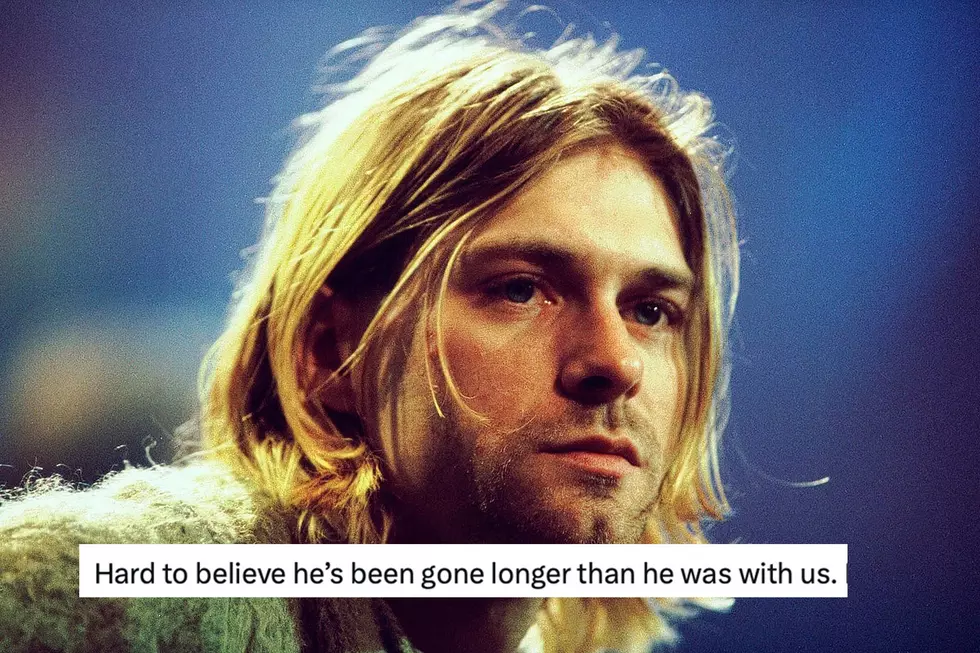
30 Years Ago + 22 Years Ago: Nirvana’s Kurt Cobain + Alice in Chains’ Layne Staley Die on April 5
Coincidentally, two grunge pioneers died on April 5 — Nirvana frontman Kurt Cobain in 1994, from a self-inflected gunshot wound to the head, and Alice in Chains singer Layne Staley in 2002, from a mix of heroin and cocaine.
Cobain died at the height of Nirvana’s popularity and his demise shook the world in the same way as the violent deaths of presidents and high-profile celebrities like Robin Williams. For many who were in their teens or twenties when Cobain’s body was found in the greenhouse behind his Seattle home, losing the singer of Nirvana was comparable to the death of a parent or other close family member. Millions identified with, and were inspired by the gifted, prolific artist, whose music resonated with equal parts rage, vulnerability and self-hatred.
Ironically, it was that very loathing that made Nirvana’s music so poignant and led to Cobain’s demise. For all the wealth, success and adoration he earned, Cobain was utterly miserable. He felt like he was pulling the wool over the public’s eyes and had become a fraud.
We’ll never know whether Cobain was lost because of his genetic predisposition to depression, his inability to kick heroin, his turbulent marriage to Hole singer Courtney Love, or his contempt at having been labeled the spokesman for a generation when he felt like he couldn’t even understand his own convoluted thoughts. Only one thing is certain. Cobain’s death was no accident, and police have very little reason to believe there was any foul play involved.
He had been using heroin for years and had overdosed on more than one occasion. On March 1, 1994, Nirvana played a show in Munich, Germany, that turned out to be their final concert. Three days later, he OD’d on Rohypnol and champagne in Rome and spent the next five days in a hospital before flying back to Seattle.
Kurt Cobain: 10 Facts You Probably Didn't Know
READ MORE: The Most Played Song Live by 15 Big Grunge Bands
The events that led up to Cobain’s climactic end are well-known by anyone who was watched ex-MTV News anchor Kurt Loder report the news, visibly shaken, in the hours following Cobain’s death.
On March 25, 1994, Love organized an intervention and the singer reluctantly entered Exodus Recovery Center in Los Angeles on March 30. The next night, the rocker climbed over a six-foot fence and escaped the facility.
Over the next few days he was spotted here and there but none of his close friends or family knew where he was. On April 8, an electrician who arrived to install a security system found Cobain’s corpse and a suicide note. A toxicology report detected a large quantity in his system as well as traces of diazepam.
The legendary last line of Cobain’s note, “It’s better to burn out than fade away” are from the Neil Young song “Hey Hey, My My (Into the Black).” Perhaps another line from the same song is more relevant for those who still cling to Cobain’s lyrics and music for strength and affirmation of individuality: “The king is gone but he’s not forgotten.”
Like Cobain, Layne Thomas Staley was an integral part of the grunge movement, but became too dependent on heroin to be able to appreciate his importance in the scene.
Though Alice in Chains started out as a hair metal band, they quickly tapped into the frustration and self-immolation of the Seattle movement in the ‘90s. The band’s dense, chugging, metallic riffs combined with soaring vocal harmonies reminiscent of Crosby, Stills & Nash defined a new style of grunge that arguably became an even more influential template for hard rock in the years ahead than that constructed by Nirvana.
As the singer for Alice in Chains, Staley was a natural — charismatic, commanding and with a voice that carried all of the power and agility of his heroes, coupled with a self-loathing caused by his insecurity and drug dependency.
Staley wasn’t the only member of Alice in Chains who used drugs, but his addiction impaired the band’s ability to tour. Even after AIC released their excellent self-titled third album in 1995, they couldn’t hit the road to support the disc. Three years after it was released, the band performed a set for MTV Unplugged, which came out on July, 1996.
Staley’s final performance with Alice in Chains was July 3, 1996, in Kansas City, Mo. — the last of four shows scheduled to support a KISS reunion.
15 Facts About Layne Staley You Probably Didn't Know
Staley never officially left Alice in Chains. However, gripped by addiction, he became a recluse and, as the years passed, in the words of Neil Young, Staley would “fade away” in the eyes of the public. Guitarist and co-vocalist Jerry Cantrell launched a solo career, but Alice in Chains remained inactive until years after Staley died.
Some fans suspected the singer’s death was inevitable.
In his final years, Staley avoided the media and rarely left his home. He was found dead in his condominium on April 19, 2002, two weeks after overdosing. His mother and stepfather had become alarmed when they were notified that Staley had stopped withdrawing money from his bank account. They called police, who broke into his home and found his corpse.
Alice in Chains fans were undeniably upset about Staley’s death, yet despite his immense contributions to grunge music, the media paid only a fraction of the attention to Staley’s death as that of Cobain. Some viewed it as a self-fulfilling prophecy, others say he burned out and faded away. Strangely Cobain, too, was a drug addict, yet many of those who considered Kurt a victim, or at the very least a tragic figure, called Staley a hopeless junkie.
“When Kurt died, he was young, beautiful, and at the height of his celebrity,” explains Mark Yarm, author of the book Everybody Loves Our Town: An Oral History of Grunge:
“It was really shocking at the time — I remember exactly where I was when I heard the news. Whereas I couldn't tell you how I heard that Layne had died. By that point, Layne had been out of the public eye for about six years, and basically dismissed as a junkie and a hermit. So, sadly, the way he went wasn't a surprise -- it was really a matter of when, not if. And by the time he passed, grunge's heyday was long over. His surviving bandmates will tell you that Layne was totally written off — he didn't even get a mention during the Grammys In Memoriam segment."
While grunge’s heyday was long over when Staley died, Alice in Chains were nonetheless able to stage an impressive comeback and remain a powerful and relevant band.
First, they performed a reunion show with various vocalists in 2005 to benefit the victims of the 2004 South Asian tsunami.
The next year, AIC played reunion shows with Comes with the Fall singer William DuVall, who eventually joined the band, sparking new life into Alice in Chains. With a small handful of new albums under the belt, Alice in Chains have been back on the road and selling out shows across the world.
Loudwire contributor Jon Wiederhorn is the author of Raising Hell: Backstage Tales From the Lives of Metal Legends, co-author of Louder Than Hell: The Definitive Oral History of Metal, as well as the co-author of Scott Ian’s autobiography, I’m the Man: The Story of That Guy From Anthrax, and Al Jourgensen’s autobiography, Ministry: The Lost Gospels According to Al Jourgensen and the Agnostic Front book My Riot! Grit, Guts and Glory.
Every 'Big 4' Grunge Album, Ranked From Worst to Best
Gallery Credit: Lauryn Schaffner, Loudwire
More From Loudwire









